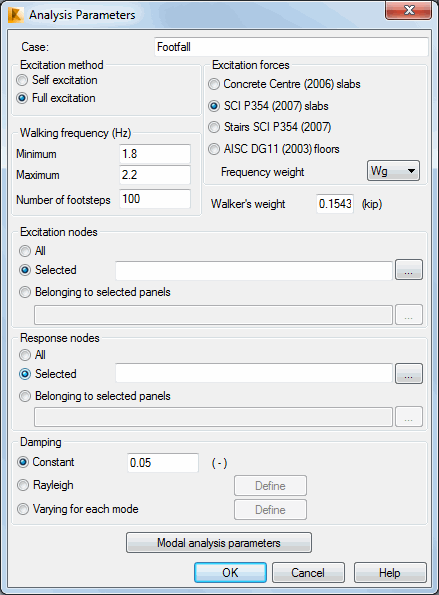Use the Footfall Analysis Parameters dialog to specify parameters for the analysis of dynamic excitation caused by foot falls from moving individuals or groups, for a load case defined for a structure.
To open the dialog:
- click the New button in the Analysis Type dialog
- select the Footfall option and click OK in the New Case Definition dialog.

You can specify the following parameters in the dialog:
- excitation method
Self excitation analyzes the response in the same node to which the force is applied.
Full excitation analyzes the response in any node, to the effect of the force applied to another node. In this case, the excitation force is applied independently on each of the nodes and there is no interaction between them.
- excitation forces
Concrete Centre (2006) slabs according to A Design Guide for Footfall Induced Vibration of Structures, M.R. Willford, P.Young, The Concrete Center 2006; the frequency interval for excitation forces is: 1.0 - 2.8 Hz
SCI P354 (2007) slabs according to SCI P354: Design of Floors for Vibration: A New Approach, The Steel Construction Institute (2007 Edition); the frequency interval for excitation forces is: 1.8 - 2.2 Hz
Stairs SCI P354 (2007) according to SCI P354: Design of Floors for Vibration: A New Approach, The Steel Construction Institute (2007 Edition); the frequency interval for excitation forces is: 1.2 - 4.5 Hz
AISC DG11 (2003) floors according toSteel Design Guide Series 11, Floor Vibrations Due to Human Activity, AISC 2003; the frequency interval for excitation forces is: 1.6 - 2.2 Hz
Frequency weight (Wg or Wb), used to calculate weighted acceleration values for excitation forces according to SCI P354
- walker's weight
- walking frequency (minimum and maximum) - a frequency interval in which to perform the analysis
- number of footsteps - a parameter that is important only for the resonant response (harmonic) analysis; a lower number of footsteps reduces a possibility of resonance
- walker's weight - a parameter that is important only for the resonant response (harmonic) analysis; for the transient analysis, the excitation force is an impulse from the force of 746 N
- excitation nodes - this option allows you to perform the analysis with excitation applied only to selected nodes (selection of nodes or objects).
- response nodes - this option allows you to limit the analysis and to calculate results only in selected nodes
- damping (constant, Rayleigh and varying for each mode) - calculated during calculations based on eigenvalues and material damping; if you select Rayleigh or Varying for each mode, the Define button becomes available; click it to open an additional dialog.
Click the Modal analysis parameters button at the bottom of the dialog, to open a dialog to define a value of the frequency limit and active mass directions.